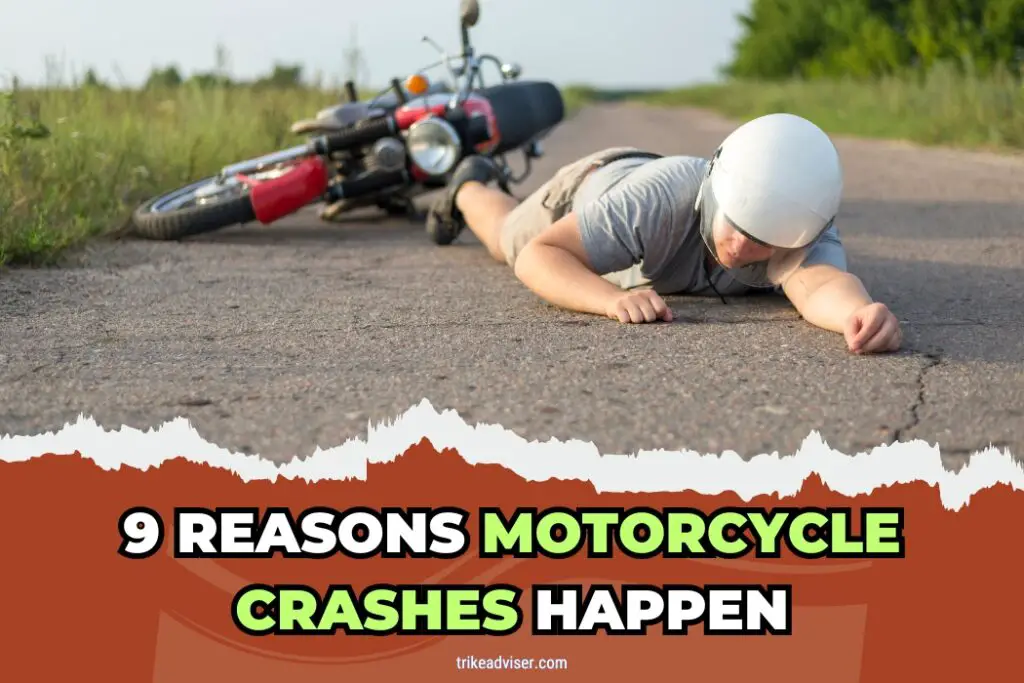Motorcycle crashes terrify even the bravest souls. A split-second change everything. You’re cruising, wind in your face, then chaos. Why does this happen? Is it speed, recklessness, or something more?
Riders and onlookers often speculate, but misunderstandings are common. Accidents don’t just happen. They’re caused. Factors vary widely – from a distracted driver to a slippery road.
Every rider knows the risks. Yet, the thrill of the ride beckons. Understanding crash causes isn’t about fear. It’s about prevention. Knowledge empowers.
It turns riders into safer, more aware navigators of the road. This isn’t just about avoiding harm. It’s about embracing the ride fully, with eyes wide open.
9 Reasons Motorcycle Crashes Happen – Avoid These Deadly Mistakes
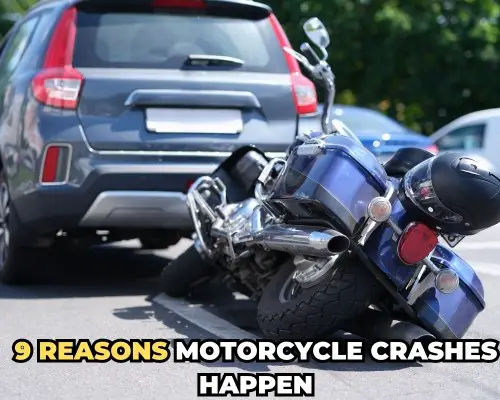
Taking Left Turns
Cars often miss a motorcycle’s turn signal. The bike slips into a blind spot, or the driver simply overlooks it. This oversight can lead to serious collisions. It’s not just about being visible.
It’s about predicting the unpredictable. Riders, be extra cautious at intersections. Signal early, and ensure you’re seen. Drivers double-check for motorcycles. Together, we can reduce these accidents.
Speeding
The thrill of speed is undeniable. But with great speed comes increased risk. Speeding cuts down reaction time. It turns minor mishaps into severe accidents.
Statistics show a direct correlation between speed and accident severity. Riders, remember: speed thrills but also kills. Keep it within limits. Life isn’t a race.
Inexperience & Inattention
New riders face a steep learning curve. The road is unforgiving to inexperience and distraction. Lack of familiarity with the bike, road conditions, or traffic laws amplifies risk.
It’s crucial to stay alert, anticipate road challenges, and continuously learn. Remember, experience is gained mile by mile, attentively.
Poor Road Conditions
Slick asphalt, uneven surfaces, loose gravel. The nemesis of two-wheel travel. Motorcycles, with their smaller footprint, demand more from the road.
Near construction sites, vigilance is key. Riders, adapt your speed and stance to navigate safely. Road awareness can mean the difference between a good ride and a bad fall.
Lane Splitting
Straddling lanes might save time, but it’s fraught with danger—and often illegal. Obscured by vehicles or blinded by glare, riders become invisible.
Accidents happen in the blink of an eye. If you must lane split, do so with utmost care. Better yet, avoid it where prohibited. Safety over speed, always.
Reckless Driving
Tailgating, weaving, speeding. Reckless driving endangers lives. Sports bikes, with their light frames and quick acceleration, are especially at risk.
The death rate is alarmingly high. It’s simple: respect the road, respect life. Drive and ride with care. The life you save may be your own.
Weather Conditions
California’s sun is legendary. Yet, storms and winds do sweep through. Poor weather affects traction, visibility, and control.
Rain slicks the road; winds buffet the bike. Visibility drops. Riders, adapt to these changes. Slow down, increase your distance, and wear appropriate gear. Safety doesn’t take a rain check.
Alcohol & Drug Use
Impairment is a deadly gamble on two wheels. Alcohol and drugs dull judgment, slow reactions, and blur vision. The result? Accidents are often fatal.
The law is clear, but so is common sense. Don’t ride under the influence. The ride you save could be your own.
Mechanical Problems
Faulty tires, engine issues, poor modifications. Mechanical failures can spell disaster. Regular maintenance isn’t just about performance.
It’s about safety. Check your bike, pay attention to warning indications, and address problems right away.
A safer motorcycle has been well-maintained. Knowing that you’ve done your share, ride with assurance.
The Psychology of Riding – Mindset and Awareness
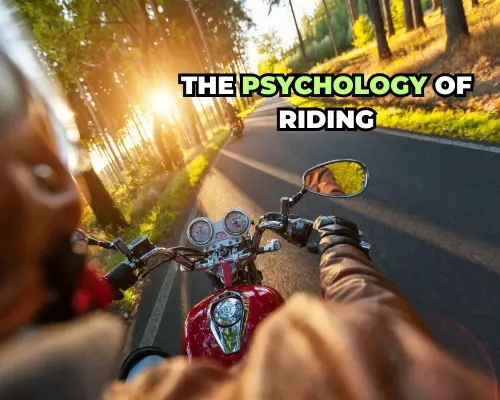
Riding isn’t just about the thrill. It’s a deep connection, a dance of life and risk. Let’s delve deeper into the mental fabric that makes a seasoned rider.
Understanding Risk Assessment
Imagine cruising down an open road, the scenery a blur of beauty. Here, risk assessment is your silent guardian. It’s not about paranoia but a deep-seated respect for the ride’s unpredictability.
- Stories from the Road: I’ve met riders who’ve seen it all. One shared how a sudden storm turned a familiar road into a treacherous path. His story wasn’t just a tale; it was a lesson in vigilance. Every ride is a lesson in humility and caution.
- A Fine Balance: Balancing risk means understanding your limits. It’s like the first time you push your bike to its limits, only to realize that true control comes from respect, not dominance, over the machine.
Cultivating Situational Awareness
Situational awareness is your sixth sense on the road. It’s the whisper that tells you to slow down, even when all seems clear.
- The Unseen Hazard: Think of the time when a shadow by the roadside turned into a deer. Such moments teach us that what we don’t see can hurt us. Always anticipate, never assume.
- Calm in the Storm: An old rider once said, “When chaos erupts, be the eye of the storm.” Panic is a rider’s worst enemy. Practice, experience, and a calm mind are your best friends.
Defensive Riding: Your Safety Armor
Defensive riding isn’t just a technique. It’s a philosophy, a way of life on the road.
- Invisibility Cloak: Assume you’re invisible because, to many drivers, you are. I remember weaving through traffic, and making eye contact with a driver. That nod we shared was an unspoken agreement of awareness.
- Space is Your Best Friend: An experienced rider once compared space around a bike to air in a balloon. It’s what gives you room to breathe, to react. Cherish it, maintain it.
The Mindset of a Rider
The road is both a teacher and a test. The mindset you bring to your bike is your most significant asset.
- Confidence vs. Overconfidence: Confidence is knowing I can handle a curve at speed; overconfidence is forgetting the gravel that might lie around the bend. The road respects humility.
- The Riding Zen: Riding has a contemplative aspect to it. It’s audible in the road’s rhythm and the engine’s scream. Riding a bike means going deeper into life, not escaping it.
Each mile traveled, each turn taken, and each challenge surmounted adds a new chapter to your riding tale. Riding safely is only one aspect of the psychology of riding; another is meeting the road head-on with an open mind and heart.
It’s about the experiences we have, the knowledge we gain, and the pure delight of riding a bike together. Never forget that each ride represents a new chapter in the grand story of your travels.
What to Do When Things Go Wrong – Emergency Handling
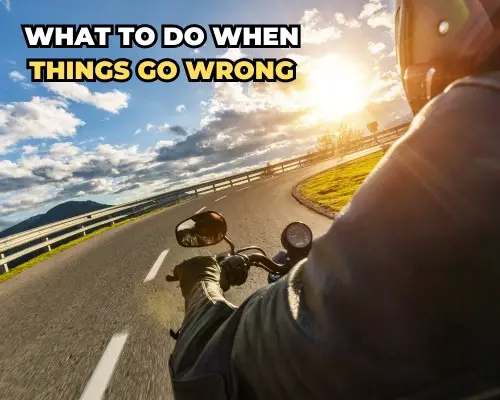
Emergencies on the road are like unexpected storms. You think you’re prepared until you’re right in the middle of one. Let’s dive deeper into stories and insights that might just save your ride.
Handling Skids: A Rider’s Tale
- The Unexpected Slide: Picture this: a quiet evening ride, the roads slightly damp from a recent rain. Then, a curve, taken a bit too eagerly, leads to a heart-stopping skid. I’ve been there. The road felt like ice beneath my wheels.
- The Calm Within: Panic clenches your chest. The first instinct? Slam on the brakes. But here’s what years on the road taught me: ease off the throttle, and keep those movements gentle. It’s like tiptoeing back to safety.
- Directing the Dance: Steer lightly in the direction you wish to go as if guiding a dance partner. It feels counterintuitive, but trust me, it’s your best bet to regain grace.
- Braking Ballet: If you must break, do so with a finesse that would make a ballet dancer proud. A gentle application can be the difference between stopping and spinning.
Mastering Sudden Stops: An Unforgettable Encounter
- The Deer in Headlights: One night, a deer decided to test my reflexes. There I was, cruising when it leaped out. My heart skipped beat.
- Brake, But Gracefully: In those split seconds, every decision counts. I applied the brakes, smoothly, evenly, front then back. It felt like defusing a bomb with each gentle squeeze.
- Practice Pays Off: I’d practiced sudden stops more times than I can count. Empty parking lots became my training grounds. When the moment came, muscle memory kicked in. Preparation turned what could have been a disaster into a story.
Navigating Mechanical Failures: Lessons Learned
- The Sudden Silence: Ever had your engine cut out on you? Middle of nowhere, just you and silence. It’s eerie. It happened to me on a deserted stretch, miles from help.
- Keep Your Cool: First step? Don’t panic. Easier said than done, but your bike’s momentum is your ally. Signal, then smoothly guide your bike to safety.
- A Prepared Mind: I always carry a basic tool kit and know a bit about my bike’s innards. That day, it turned a potential tow truck call into a fixable roadside stop.
Emergency Mindset: The Inner Game
- Anticipation Is Key: Like a chess player, always be three moves ahead. Observe, anticipate, and have a plan. This mindset isn’t born overnight. It’s cultivated through miles, experiences, and sometimes, close calls.
- Your Escape Plan: Always scanning for that ‘out’ becomes second nature. It’s like having a mental map of safe havens, constantly updated as you ride.
- Lifelong Learning: The day you think you know it all is the day the road will surprise you. I devour books, courses, and stories from fellow riders. Each one adds a layer to my emergency handling arsenal.
Every rider has their tales of close calls, moments where time slows down, and decisions matter most. These aren’t just stories; they’re lessons etched into the soul of a biker.
They remind us that, on the road, being prepared, staying calm, and learning from every ride isn’t just about safety—it’s about embracing the ride with wisdom and respect.
Road Rage and Motorcycles – Keeping Cool Under Fire
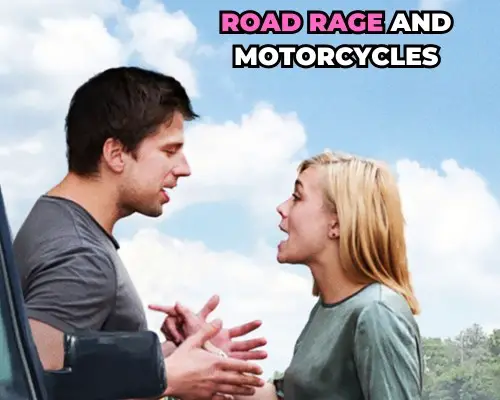
It takes more than just competence to navigate the rough seas of road rage; it takes a great deal of self-control and elegance. Let’s delve farther with understandings based on individual experiences and accumulated knowledge.
Recognize Signs of Aggression
- The Subtle Clues: I recall a ride during rush hour; a car swerved close, its driver yelling through the window. It was a clear signal to back off. Like the change in the wind before a storm, aggression on the road has its tell-tale signs. Spotting these early can spare you from getting caught in a downpour of rage.
- Learning from Every Encounter: Each ride teaches you to read the road’s mood better. It’s about accumulating wisdom mile by mile. Remember, recognizing aggression is as much about intuition as it is about observation.
Avoid Provocation
- The Art of Non-Engagement: It’s tempting to respond in kind when provoked. I learned the hard way that this only escalates matters. Once, a simple eye roll turned a heated moment into a prolonged chase. Since then, I’ve learned the power of neutrality. A neutral response can disarm aggression, leaving the aggressor with no fuel to continue.
- Choosing Peace Over Pride: It’s not about who’s right, but who’s wiser. Wisdom lies in choosing safety and peace over the fleeting satisfaction of having the last word.
Maintain Emotional Control
- A Test of Will: Controlling your emotions in the face of provocation is a true test of character. I remember counting to ten under my breath, each number a step back from the brink of anger. It’s a simple technique, but it’s saved me more times than I can count.
- The Calm Mind Prevails: A calm rider can navigate through chaos with ease. This tranquility doesn’t come overnight but is cultivated through practice and reflection.
Give Space and Maintain Distance
- Strategic Retreat: There’s bravery in choosing to distance yourself from conflict. I once had to take a longer route just to avoid an aggressive tailgater. It added minutes to my journey but gave me hours more peace of mind.
- Safety in Space: The more room you give an aggressor, the less likely a confrontation will escalate. It’s not just physical safety; it’s psychological relief as well.
Report Dangerous Behavior
- Civic Duty: Reporting isn’t about vengeance; it’s about responsibility. After witnessing a particularly dangerous display of road rage, I reported the vehicle. Weeks later, I learned my call had led to an intervention that possibly prevented further incidents. It was a reminder that our actions have wider repercussions than we might see.
Practice Defensive Driving
- Anticipation is Your Shield: Defensive driving is proactive, not reactive. It’s about anticipating others’ actions before they make them. This foresight is like a sixth sense developed through experience and close calls.
- The Space Cushion: Keeping a safe following distance isn’t just a good practice; it’s a buffer against the unexpected. This space is your cushion, absorbing the shock of sudden aggression or erratic behavior.
Use Verbal and Non-Verbal Communication
- The Power of a Gesture: A simple wave or nod can diffuse tension like a balm. I remember a tense exchange that was softened by my raised hand in acknowledgment. It wasn’t an apology but an olive branch, a gesture of peace.
- Speak Without Words: Our body language speaks volumes. Learning to convey calm and non-threat through posture and gestures can often speak louder than words.
Dealing with road rage is a skill refined by experience, a delicate balance between assertiveness and restraint. Each encounter is a lesson, each mile a story.
Remember, the road is a shared journey, and how we navigate it defines not just our ride, but us as riders. Let’s choose the path of peace, patience, and respect.
As an Amazon Associate, I earn from qualifying purchases, at no additional cost to you. Read Our Affiliate Disclosure.

